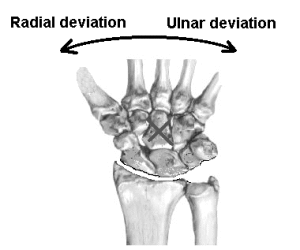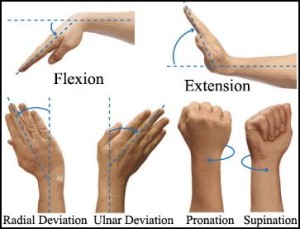If you are an ICA member, or have known me for a long time in the Spinning® and indoor cycling community, you would probably know that I’m not a big proponent of standing out of the saddle with the hands on the tops of the handlebars. That would be a “Standing Flat” or a “Run With Resistance” in Spinning parlance. Doing this has led to some of the flagrant form issues in indoor cycling classes because it allows (in fact, it encourages) the tendency to unfold at the hips, either accidentally or on purpose—some instructors (and even some programs) actually promote this upright position. It has led to people perching on fingertips, which makes riders look like meerkats or like they’re drying their nails. It causes choppy pedal strokes. It can be dangerous because an overly upright position can lead to hyperextension of the knees. But primarily, riding with the hands here, whether you are bolt straight or flexed, is a less effective cycling position and you simply cannot do as much work (i.e., power output, burn calories, etc.) as you could if your hands were on the sides.
I’ve always advocated moving the hands to the sides (either just past the bend or on the ends) of the bars whenever you stand up, because that is what you do on a bike outside 99.5% of the time. Cyclists do this for several reasons. First, it provides more stability. Sure, outdoors the bike is moving side to side and we need to help stabilize it, something we don’t need to do indoors. However, it helps to stabilize your upper body relative to the bike, much more so than when your hands are on the tops. It also provides more leverage when additional power is needed, such as a surge in effort, an attack, or just simply climbing. In other words, the Spinning position “Run With Resistance” would have more potential for power if you simply did the Spinning position called “Standing Climb.”
It is also easier on the wrist joint. The wrists have limited motion to the thumb and pinky sides, a movement called radial deviation (to the thumb side) and ulnar deviation (to the pinky side). We also have little strength in this direction compared to flexion and extension. When you stand up in a “run,” with your hands on the tops of the bars, radial and ulnar deviation is what is taking place at the wrist joint. This lateral movement puts pressure on those tiny wrist bones, especially if the rider is inclined to lean on the hands (very common).
Conversely, when you move the hands to the sides, your body position now allows flexion and extension of the wrist joint as depicted in the image below. It’s much easier on the joint, and you have more potential power because of the flexors and extensors of the forearm. When you need leverage for a powerful out-of-the-saddle attack (even on a flat road), it is de rigeur that you move the hands to the sides.
How a Cyclist Rides
ICA member Chuck Gauran brought this wonderful video from the Global Cycling Network to my attention. The narrator is discussing where and why a cyclist should put his or her hands on certain parts of the handlebars in various scenarios. Obviously since our indoor bikes don’t have drops, you can ignore that part for your indoor rides (although if you’re an outdoor cyclist, you’ll learn how powerful it is). But pay attention to what he says about riding with your hands on the tops of the bars at 2:07…
“Never ever ride out of the saddle like this, simply because you look like an idiot!”
Well, I guess that’s another reason not to do it! The reasons a cyclist would look like an idiot are as I explained above—it’s ineffective, unstable, and uncomfortable…and apparently dorky.
Chuck and I were having a discussion on Facebook about this video and he asked why a major indoor cycling program would encourage this.
Here is my experience when I was a Spinning MI. Riding with the hands on the sides, about where the hoods would be on an outdoor bike, is referred to as “Hand Position 2.5” and was never an “official” hand position in the program. It still isn’t. In fact, it was verboten, sometimes rather strictly by some in the program. I heard stories of instructors telling serious cyclists that they couldn’t ride in that position in their class. It’s no wonder why so many cyclists were turned off by Spinning.
Early in my master instructor days I asked the powers that be why we couldn’t ride in HP 2.5, even though as a cyclist I did it safely all the time. One of the responses was that there’s a “danger of slipping.” It doesn’t seem to me to be any more so than anywhere else on the handlebars, and besides, most people hook their thumbs. Also, those original slippery glossy handlebars on the first editions of the bike are long gone. Another response was that “it externally rotates the humerus.” Um…yeah, like it’s supposed to! Better use of the arm muscles, more leverage, more comfort. In tennis you are taught to shake hands with the racket; that’s exactly the same position of the hands on the sides of the bars.
Most of the time they couldn’t tell me why. It was “just because” or “that’s the way it is.” This is now entrenched in indoor cycling and has led to the woes I explained above. All of those issues would be cured if people just put their hands on the sides when they stand up. When your hands are there, you maintain the correct bend in the hips and cannot “unfold” and become a meerkat. There is nothing contraindicated about that!
Nowadays, some of the more cycling-oriented master instructors do say that HP 2.5, though not official, is not contraindicated, and if instructors/students want to, they can ride there. I know I did for years, and talking to many of my peers, they did too. My question is, in that case, why not make it an official hand position in the program?




Jennifer,
Thanks for this information especially with the questions i had in a recent email to you!! Thanks.
Jennifer,
Thank You so much for this information especially after the questions I had in a recent email i sent to you. Thanks again!!!
Nice video, short, sweet and to the point. I agree with your points in the write up Jennifer. Stealing this a little, when watching the vid, and particularly the drops, I wonder whether this is the reason why particpants tend to do the arms on the handle-bars, thinking that it will give them more power, which we know does not and why outdoor riders get ticked off when we coach not to do it and why. Just a thought.
With most of the older bikes (actually all of them) I know the handlebars first part going ahead is at a degree which forces ulnar deviation when holding there while standing. Personally I find this uncomfortable and rather prefer position 2 or 3 as on the MTB outside, but I ride with real resistance indoor. The new Schwinn A.C. series bikes have their handle bar ahead section inclining allowing position 2.5 without hand deviation, which is why Schwinn permits position 2.5 on these bikes. I guess it will take some time until position 2.5 is promoted and fully established for fast standing, but at least it is a step into the right direction to “keep it real”.
Fantastic write up and the explanations are awesome. Good stuff to take to a class. thank you
Good points! Nice video!
Laree, not sure why it didn’t work for you. Here’s the Youtube link, perhaps that will work. http://www.youtube.com/watch?feature=player_embedded&v=28ADO9pC1BY
Well written and soooo true! Love the meerkat description! lol
Wish the video had worked, would like to see it!
Amazing.